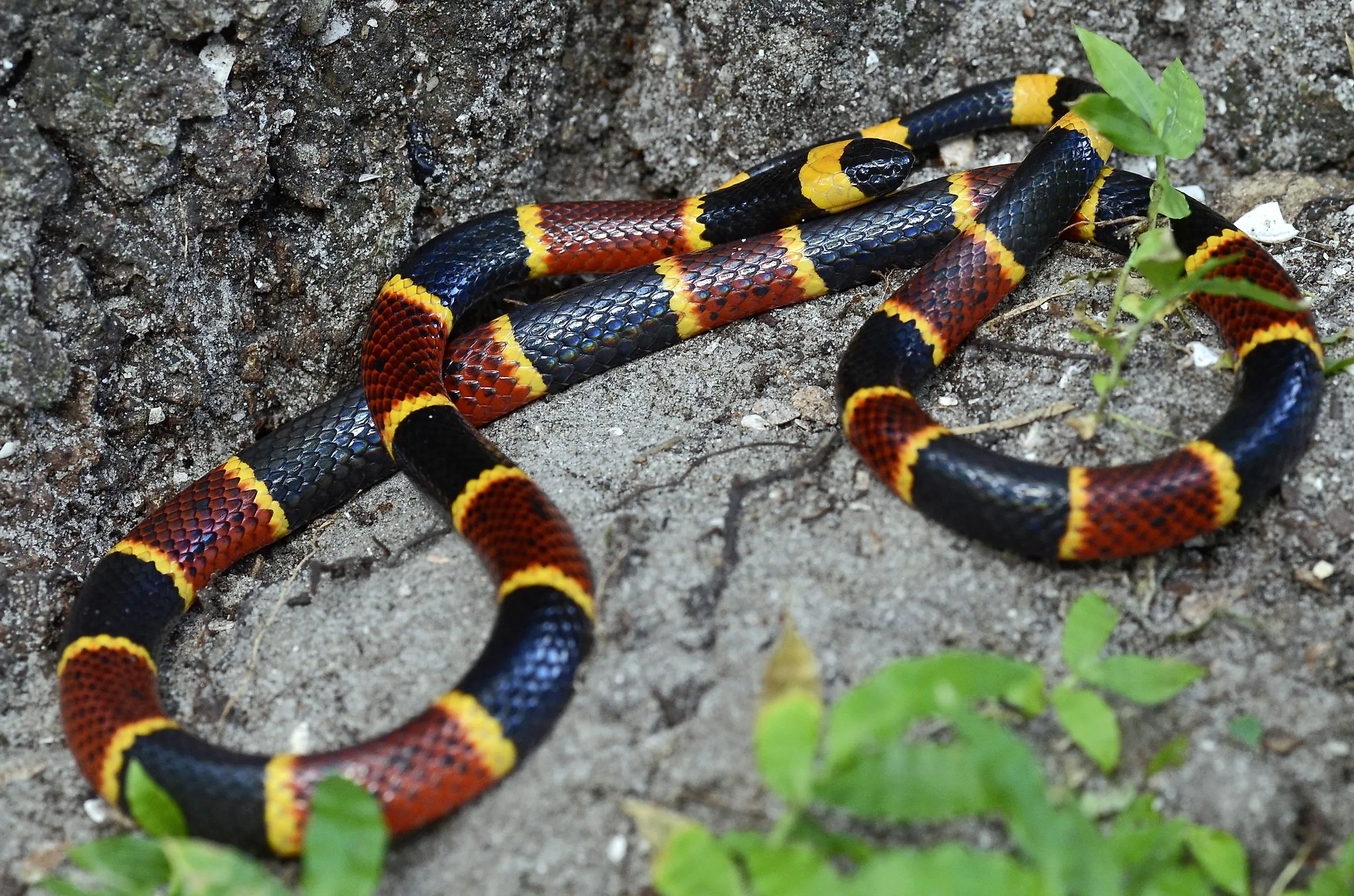
The 13 Most Snake Infested Areas In Florida
Snakes are a valuable part of Florida’s ecosystem as prey and predators. They control the populations of rodents and insects. But the rise in invasive, non-native, dangerous snakes throws the ecosystem out of balance. Floridians and researchers alike fear that these snakes will permanently damage the ecosystem by eliminating crucial key animals.
There are 46 species of snakes native to Florida, and only six of these are venomous, along with the five species of non-native and well-established snakes. Three of these (Boa Constrictors, African Rock Pythons, and Burmese Pythons) are invasive species and are causing shifts in the natural ecosystem. Burmese Pythons are by far the most invasive species in Florida, able to challenge even apex predators like alligators and crocodiles. Below are 13 of the most snake-infested areas in Florida and some of the reasons for the populations.
Apalachicola
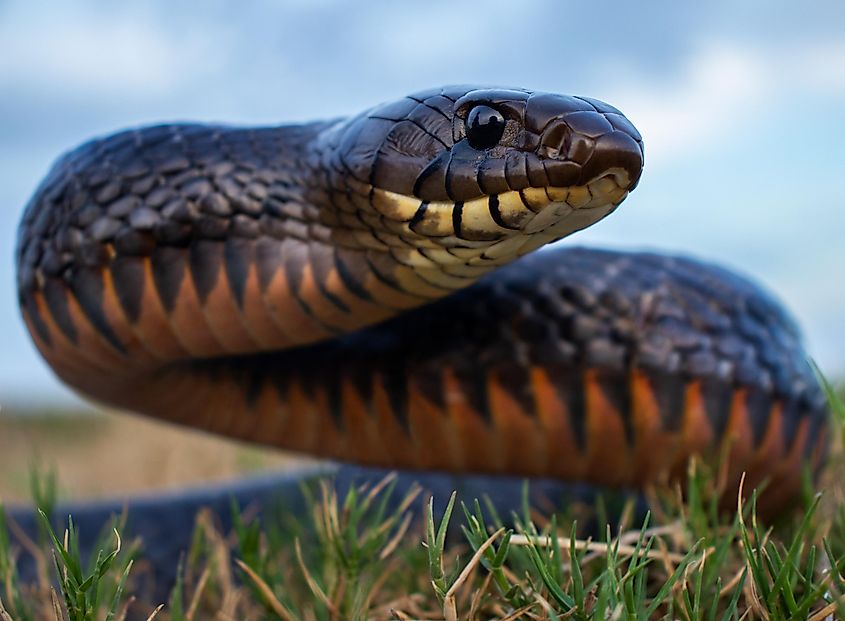
Indigo snake with its head raised.
In the bluffs, ravines, and forests of Apalachicola, many snakes from the 41 species known to northern Florida can be found. Most snakes thrive here among the subtropics, but one species, the Eastern Indigo Snake, nearly vanished from the region entirely. The reason for this sudden decrease in Indigo Snakes was directly linked to the endangered Gopher Tortoises, which created the habitats of the snakes among other animals.
Because of the decrease in Indigo Snakes, other species went unchallenged without one of their main predators. Researchers have been quick to resolve the issue by breeding Indigo snakes in the Central Florida Zoo and reintroducing them into the Apalachicola Bluffs. So far, 126 Indigo Snakes have been reintroduced into the wild. All of this shows the importance snakes can have on an ecosystem.
Tampa Bay
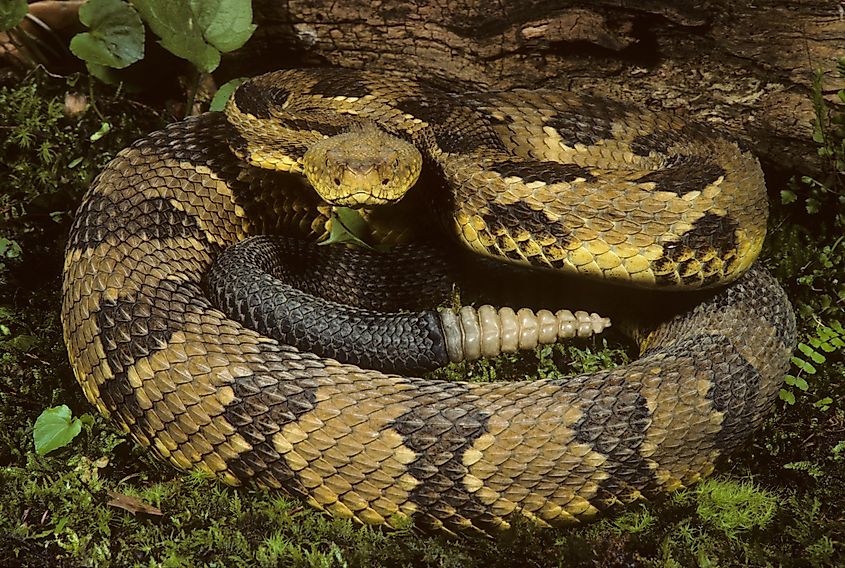
Coiled Timber Rattlesnake (Crotalus horridus) in New Jersey.
Three of Tampa's most common venomous snakes are the Timber Rattlesnake, the Water Moccasin, and The Eastern Diamondback Rattlesnake. These snakes thrive in the bay because of the hot, humid subtropical weather in the area and the easy source of food, water, and shelter.
It is important not to fall into popular myths about these potentially deadly animals. They are not aggressive and usually avoid people but will bite if aggravated or startled. Rattlesnake likes to hide under lumber and in rocky crevices and, contrary to popular belief, does not always rattle before striking. Water Moccasin (AKA, Florida Cottonmouth) can often be found cooling off in swimming pools or other bodies of water. If encountered, the best thing to do is contact snake removal professionals and give the snake plenty of room.
Lake Talquin State Forest
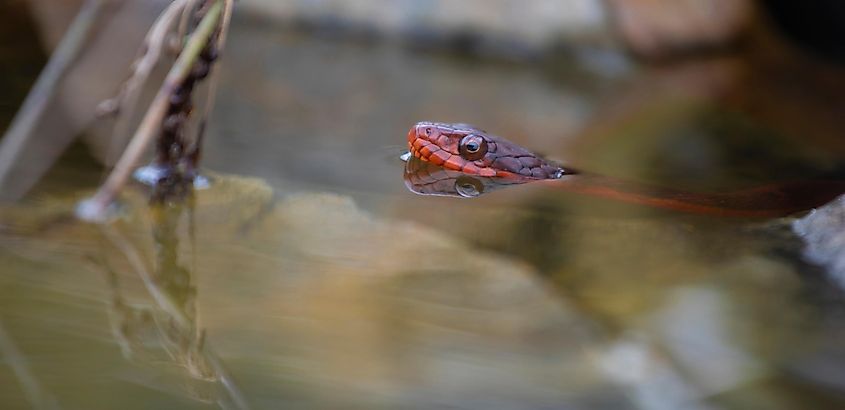
Red-bellied watersnake with its head emerging from a small pool of water.
Lake Talquin is a 10-square-mile lake with roughly 40 miles of shoreline. The state forest has a total of nearly 19,380 acres of protected land. This makes for the perfect sanctuary and habitat for snakes of all kinds. The most common snakes in the area are Red-Bellied Watersnakes, Water Moccasins, and Brown Watersnakes, but there are a total of 41 species that can be found in the area.
Despite the number of snakes in the lake and forest, Floridians still enjoy camping, canoeing, and fishing in the area. In Florida, snakes are a constant animal that residents must become accustomed to. Many people keep snakes as pets, which is how some of the non-native species came to Florida in the first place.
Aucilla River
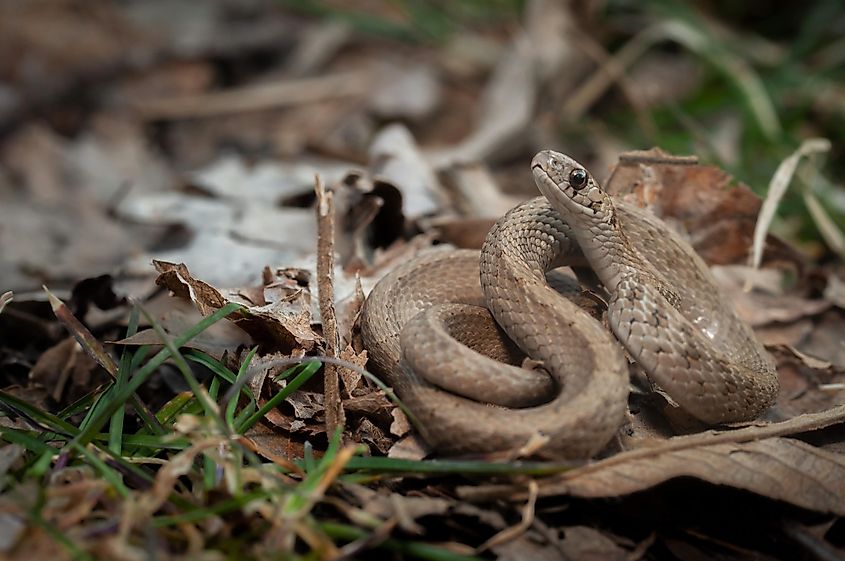
Macro portrait of a Dekay's brown snake.
Aucilla River feeds from Sneads Smokehouse Lake and stretches for almost 89 miles before letting out into Apalachee Bay. The river has a drainage basin of 747 square miles which is a Marine protected area where snakes often collect. One of the most common snakes along the river is the Dekay’s Brown snake, a small, thin, non-venomous snake rarely reaching more than 13 inches in length.
Kayakers and fishermen may encounter these animals while on the river but should know they are relatively harmless unless provoked. Dekay’s Brown snake is less likely to be found on the east side of the river, likely due to a higher level of predators present.
Peace River
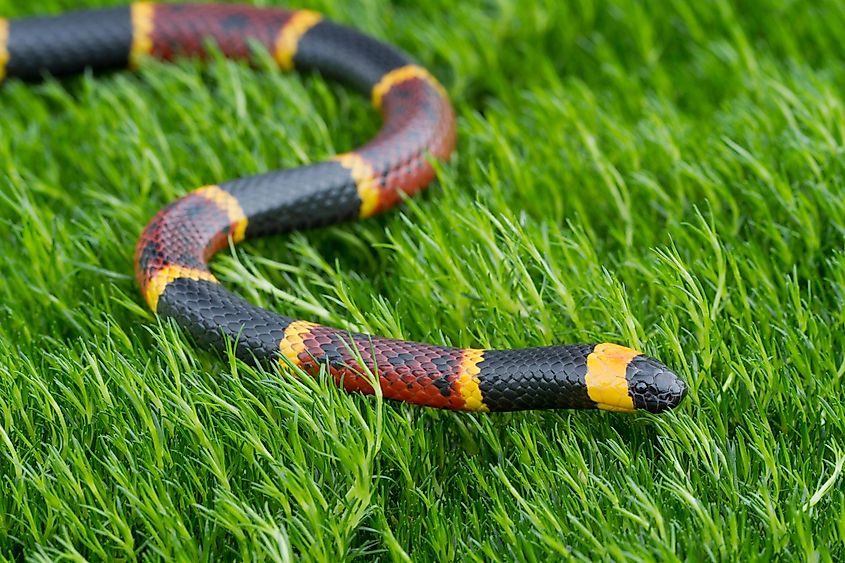
Along the Peace River, 18 species of snakes have been documented by the Peace River Wildlife Center, including six venomous snakes and the deadly Eastern Coral Snake. The Eastern Coral Snake is one of the most venomous snakes in North America and one of only a few snakes in the cobra family present in the US.
Coral Snakes like to live in areas that have excellent drainage, like the area around the Peace River, and can often be encountered by farmers seeking the same land for crop production. However, these, like most snakes, are not naturally aggressive towards people and will flee if given the option.
Manatee River
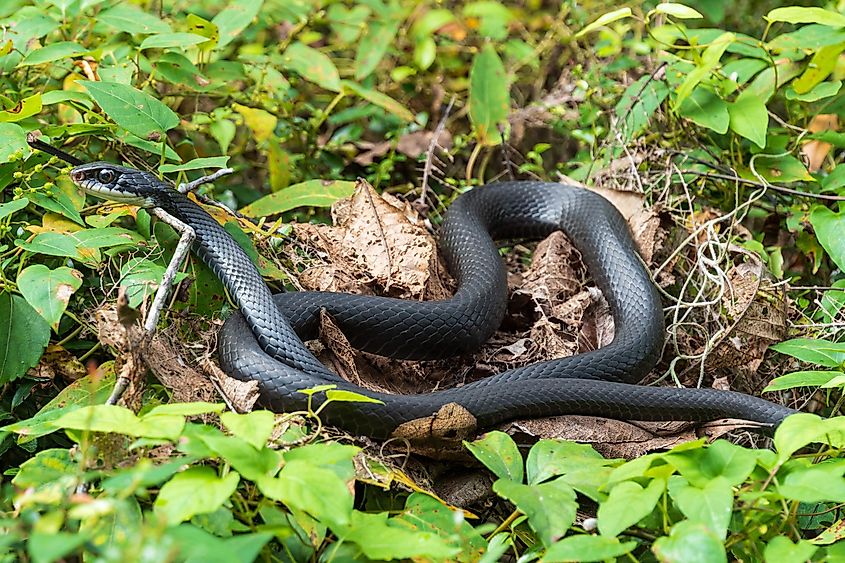
Common non-venomous snakes around the Manatee River are the Southern Black Racer, Corn Snake, Yellow or Eastern Rat Snake, and Gray Rat Snake. The River makes for a great source of food as prey animals to the snakes come seeking water. The damp climate also makes for great nesting among snakes.
The venomous snakes in the area include the Water Moccasin, the Pygmy Rattlesnake, the Eastern Diamondback, and the Coral Snake. Experts advise against this 36-mile-long river full of not only Water Moccasins but also American Alligators, a common predator of snakes. Despite the predators, snakes still thrive in the area due to the climate and water access.
Lake Istokpoga
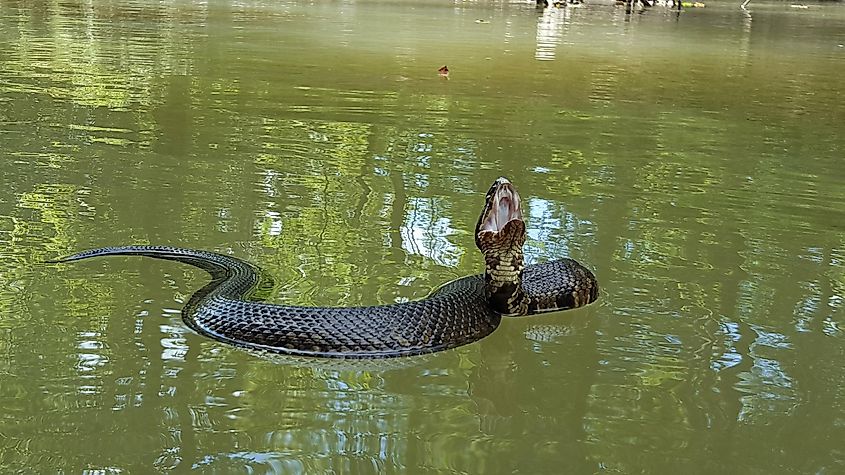
Water moccasin floating on water.
Nearly 27,692 acres, Lake Istokpoga, is a common waterhole infested by snakes like the Water Moccasin and non-venomous Eastern Mud Snake. A typical food source for the snakes here is the significant number of Osprey nests. Snakes can often be found sneaking into bird nests and devouring eggs whole despite the Osprey being a potential predator.
Snakes in this area may be numerous, but they are far from the top predators, as nearly 10,000 alligators inhabit these waters. However, as the non-native Burmese Python invasion moves further north, disrupting natural ecosystems, the local alligators begin to be challenged for the top spot.
Upper Kissimmee Basin
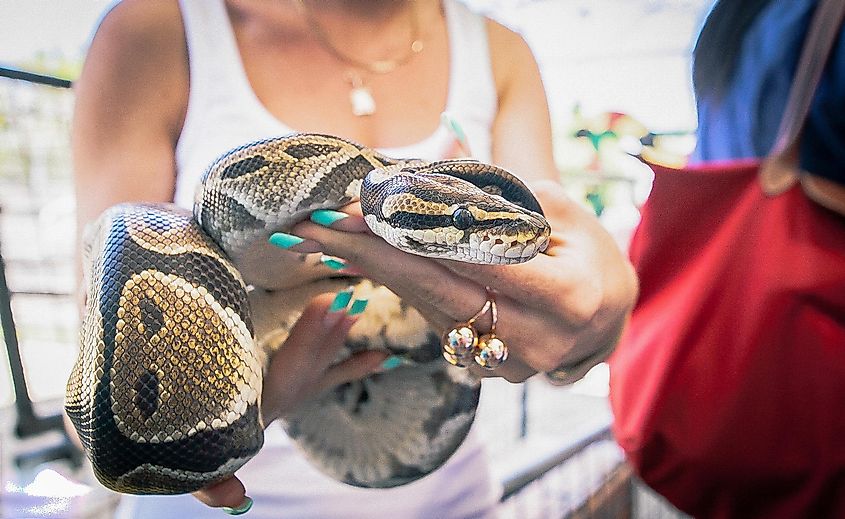
A woman holding a large python snake.
The State has extensively modified the Upper Kissimmee Basin to control flooding in the area. But because of the previous flooding and current water features, the area is full of wetlands and marshes, which create a home to some of the largest snakes in the state.
With the Python invasion to the south, many snakes have been pushed up into the basin and further north. Other non-native species, such as the Anaconda, have been spotted in the basin. One such report mentions a 12-foot-long Anaconda captured in the Kissimmee River.
Ocala National Forest
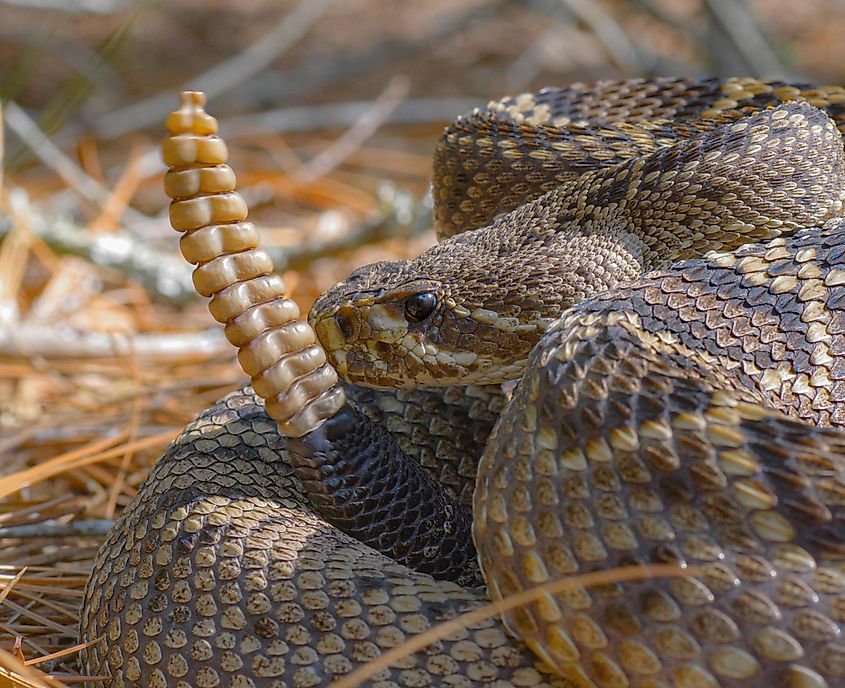
Native to the Ocala National Forest are dozens of snakes but only four venomous species: the Water Moccasin, the Eastern Diamondback Rattlesnake, the Dusky Pygmy Rattlesnake, and the Eastern Coral Snake. The National Forest consists of 673 square miles of dense underbrush with many small streams and creeks giving homes to snakes.
Hikers and mountain bikers can often encounter one of these snakes, and if they do, experts suggest waiting for the snake to pass and giving them plenty of room. Fear of these animals is understandable, but most snake bites come from people trying to move or capture snakes without proper training.
Potts Preserve And Wildlife Management Area
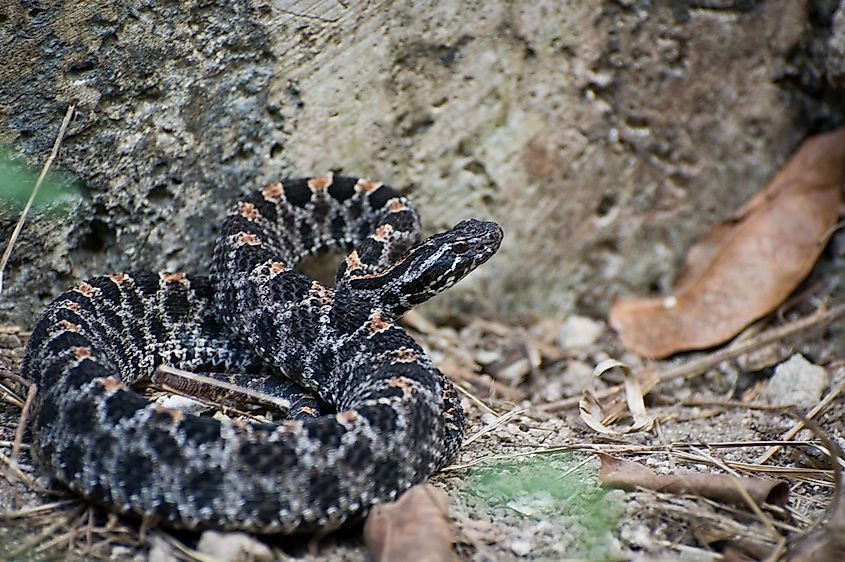
Pygmy rattlesnake.
Snakes are all over these wet marshes and rivers in Potts Preserve. Hunters and boaters may come across any number of snakes, such as common Florida rattlesnakes and Water Moccasins. The wetlands in this area are essential parts of the Tsala Apopka Chain of Lakes and the Withlacoochee River systems, providing habitats to multiple common watersnakes and other reptiles.
Researchers hope the conservation efforts in this area will show the importance of preserving reptiles and snakes in their natural habitats and preventing the spread of non-native species like Pythons.
Three Lakes Wildlife Management Area
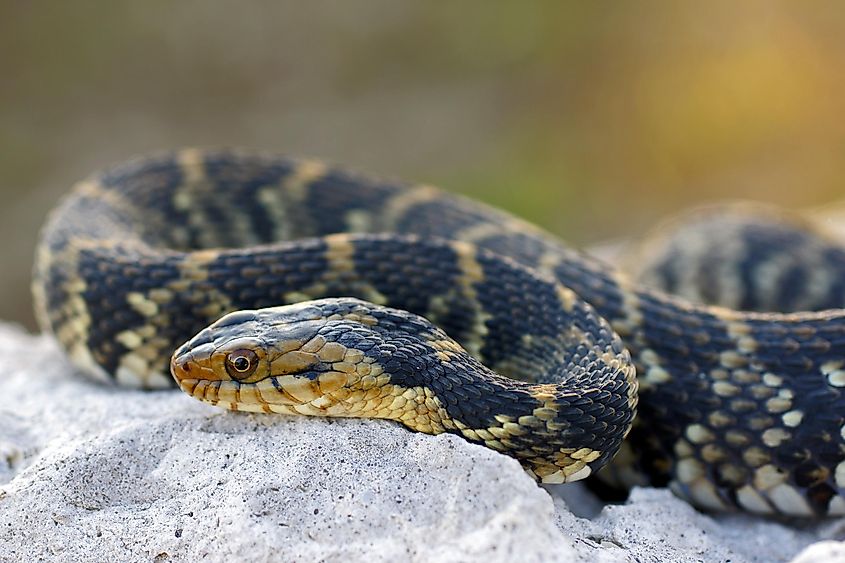
Banded water snake (Nerodia fasciata).
The Three Lakes Wildlife Management Area includes Lake Kissimmee, Lake Marian, and Lake Jackson. Four observations of the Eastern Diamondback Rattlesnake and three of the Eastern Coralsnake have been documented in this region. Garter snakes and Banded Water Snakes are commonly seen here.
The abundance of small birds, frogs, and insects offers an excellent diet for these snakes. There are currently no reported sightings of pythons in the area, which further supports the presence of native snake species.
Lake Okeechobee
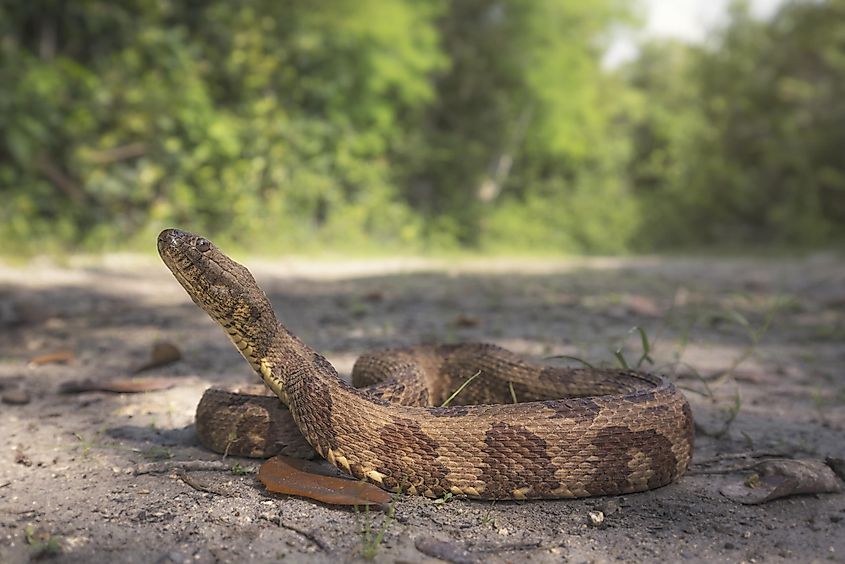
Lake Okeechobee hosts a rich and varied ecosystem, including numerous snake species. Among these, the most prevalent are the Brown Water Snake, Banded Water Snake, Florida Green Water Snake, Water Moccasin, and the invasive Burmese Python. Fortunately, python sightings in the lake have been rare, which has allowed native species to flourish.
Unfortunately, this lake ranks as one of the most polluted in southern Florida, suffering from stormwater runoff and agricultural chemicals contaminating the water. Yet, snakes and other reptiles continue to thrive in and around the lake; however, people are advised against swimming or engaging in other water activities.
The Everglades
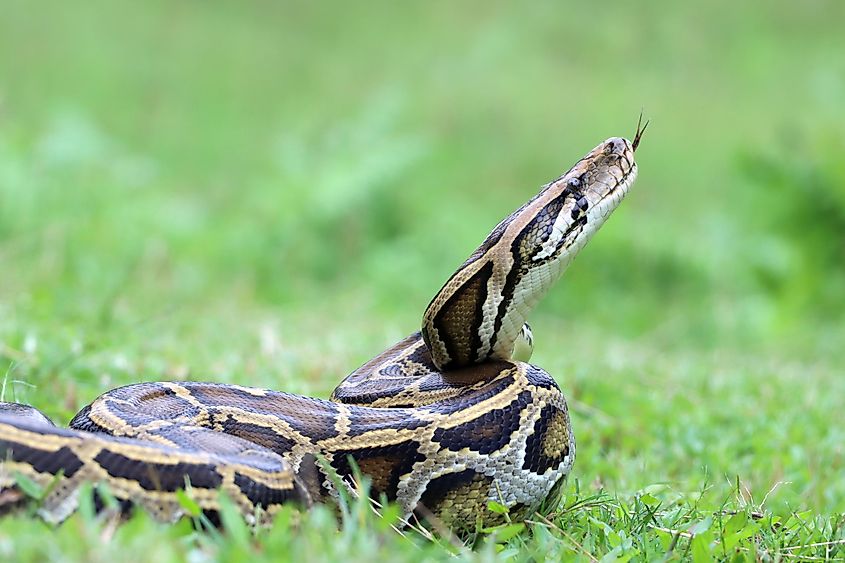
The famed Everglades of southern Florida are the most snake-infested area in the state, primarily due to the invasive non-native species, the Burmese Python. These snakes were initially brought from South Asia as pets and zoo exhibits but escaped during devastating tropical storms. Pythons have no natural predators in Florida and view everything as prey. They consume other snakes and have even been known to eat adult alligators and crocodiles. Burmese Pythons are one of the largest species of snakes in the world, often exceeding 22 feet in length. Researchers have conducted numerous studies on the impact of the python invasion in southern Florida and its overall effect on the ecosystem. Residents have been encouraged to hunt these invaders to control their population and allow other species to recover.
The Role and Future of Snakes in Florida's Ecosystem
Snakes are important predators and prey in Florida and are invaluable to the ecosystem. However, when non-native species like pythons were introduced, they had no natural predators. This led to the disruption of natural ecosystems, as they became the dominant species in the most snake-infested areas of Florida. Conservation efforts have been largely successful in bringing back endangered species like the Indigo Snake and restoring balance to many areas while pushing back against invasive snake species.
People who have snakes as pets should take care to secure them in case of a storm because even one or two invasive species introduced to an ecosystem can be disastrous. Residents should do all they can to learn about their serpentine neighbors, as in Florida, these animals are abundant throughout the land. Researchers encourage residents to aid conservation efforts and volunteer at research centers and preserves. Only with a better understanding of these creatures can people truly come to respect them.











